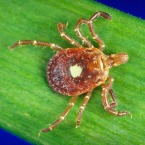Infections from ticks are on the rise in the United States. But while many parents know about
Lyme Disease, fewer may be aware of other illnesses children can get from ticks. Fever, headache and other flu-like symptoms a week or two after being bitten by a tick, for example, could be symptoms of
human ehrlichiosis infection.
How is it Spread?
Human ehrlichioses infections are caused by at least 3 different types of bacteria that are spread through bites of infected ticks—Ehrlichia chaffeensis, Ehrlichia ewingii, and
Anaplasma spp.
 Lone star ticks(Amblyomma americanum), named for the single white dot on their backs, are the primary way humans are affected with ehrlichioses. In addition, lone star ticks are aggressive human biters—the most common tick reported to bite humans in the southeastern and southcentral United States. However, there have been reports of long star ticks in states as far north as Minnesota and New Hampshire.
Lone star ticks(Amblyomma americanum), named for the single white dot on their backs, are the primary way humans are affected with ehrlichioses. In addition, lone star ticks are aggressive human biters—the most common tick reported to bite humans in the southeastern and southcentral United States. However, there have been reports of long star ticks in states as far north as Minnesota and New Hampshire.
Deer ticks (Ixodes scapularis) and
dog ticks (Dermacentor variabilis) also can be infected with and spread the bacteria causing human ehrlichioses.
Signs and Symptoms:
Ehrlichiosis infections have signs and symptoms similar to influenza (the flu), including:
In some cases, the child may also develop a rash, cough or confusion. These symptoms typically begin 5 to 10 days after the tick bite. It is important to remember that tick bites often go unnoticed. Many people with tick-borne infections do not realize that a tick has bitten them.
What Parents Can Do:
Call the pediatrician. Children, or their parents, may not notice if they've been bitten by a tick. Call your pediatrician right away if your child has these symptoms—especially if the family recently spent time in nature areas. Your child may need lab tests and may receive a prescription antibacterial medication, usually doxycycline, if it turns out he or she has a human ehrlichiosis infection. Most children with ehrlichioses who are treated will recover completely within 1 to 2 weeks.
Prevent exposure. Limit your child's exposure to ticks and bacteria they may carry as much as possible. Steps that can help include:
Stick to the beaten path. Try to stay on the trail in wooded areas where ticks are known to be a problem. Avoid playing in tall grassy areas or those with a lot of leaves on the ground, habitats that ticks also love.
Backyard basics. Keep lawns where children play mowed and raked. Try to set up play equipment, such as swing sets, in sunny, dry areas away from wooded edges of yards.
Cover up. Dress your child in a hat and long-sleeved shirt and long pants that cover most of the body. Tuck pant legs into his or her socks.
Use insect repellent. Apply an EPA-registered
insect repellant to exposed skin in a ventilated area. For example, repellents containing 20-30% DEET are safe and effective when used as directed for children. Products containing plant-based picaridin can also be used on skin and can help keep ticks off. Reapply every 6 hours or according to label instructions. Permethrin products can be used to treat clothing and gear, but should not be applied to skin.
Don't forget pets. Treat pets with tick repellents as advised by your veterinarian.
Wash off. Bathing or showering after coming inside makes it easier to spot ticks that may be crawling or attached to the skin. Be sure to check less visible spots such as folds of skin, behind the ears, and the scalp.
Remove ticks. Gently
remove any ticks you see as soon as possible to minimize exposure to the bacteria they may carry. Using tweezers, pull straight out without twisting. After the tick is removed wash the area with soap and water.
Use the dryer. To help kill ticks, put clothing right into the dryer, if possible, on high heat for at least 10 minutes.
If you have any questions about tick-related illness, talk with your pediatrician.
Additional Information & Resources: